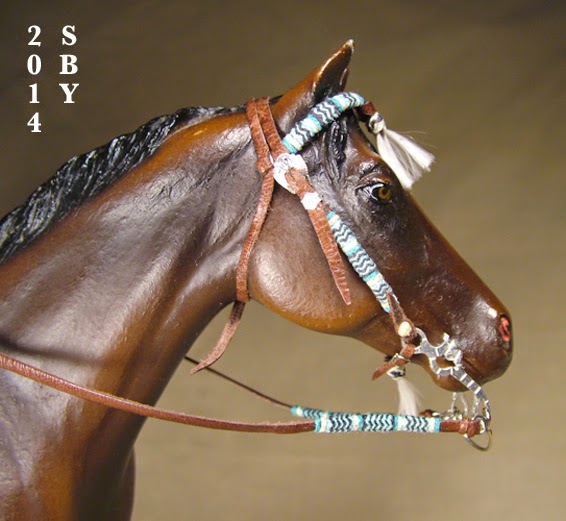I started out working with my Red Leopard Appaloosa Lady Phase, but by the time I reached this stage I was searching for a dark horse. Such a bright bridle needs a darker background; never mind the dark brown of the lace.
The hard part was the buckles.
They are individually hand made from sterling silver, and of course hand engraved. Those itsy-bitsy keepers are the smallest silver parts, to date, I've ever made. The reference picture I had (see below) did not show the throatlatch fastening, nor the near side of the bridle at all. One has to rely one's experience for such things... on the near-universal pattern of symmetry and matching parts in horse tack. No matter how tempting otherwise, unless there is a specific reason not to, tack must be made symmetrical.
As ever my buckle tongues, and the brow concho wire in this case, are made of stainless steel.
I could not resist putting this newly-finished beauty on my newly-acquired Snowman:
This is how you find out, as a tackmaker, how big each new mold is. (This's my first Idocus.) Snowman/Idocus is considerably bigger than Lady Phase [LP]. Still it fit him. He looks great! Normally I don't care for greys and cold colors, but this boy sneaked in under the radar... I guess sometimes I need something different, for at long-separated but regular intervals I have fallen for grey horses, and those few remain some of my absolute favorites. Perhaps their lack of color accents their personality.
As a designer of complete saddle sets, I'm always looking for ways to unite the piece. We know what the customer asked for with the bridle:
 But here's the saddle she asked for hers to be based upon: TSII #419, built in 2001, called the Celtic Cutter.
But here's the saddle she asked for hers to be based upon: TSII #419, built in 2001, called the Celtic Cutter.Apologies to Andrea; I haven't your email and so can't ask permission to re-post this picture. : ( It perfectly shows the carving pattern and the front of this saddle, as well as a closer look at the tassels. Tassels! Here is the design element that I will be using to help connect the two rather disparate halves of my customer's saddle set.
You would think the obvious link would be the braiding of the cantle, pommel, horn and stirrups. Aren't I famous for braidwork on saddles? But think: triple-color (let alone 4-color, which this bridle is) braiding is extremely difficult (I've only done tri-color once on a cantle). Something in me resists the idea of a fairly plainly carved natural saddle overdone in screaming turquoise. She didn't ask for that. She gave me free rein, bless her heart.
It's a challenge. Should I use sinew, so clearly (and beautifully) shown on TSII #419? But where is the sinew on the bridle? It didn't use any. Putting some on afterwards is kind of out of the question... I've painted myself into this corner: What to use for the edge braiding, since there must be some?
I thought about black and offwhite. That would be loud, but possible. I rather like the pure-rawhide approach. Would just the offwhite / pale-banana-color thread work? Here are the threads and their leftovers:
This picture, incidentally, shows the work that went into two of the 4 colors of thread, the two on the right (turquoise and light turquoise). Since the thread off the spool was too thin (too small a gauge) I spun it larger, doubling it. It was a bit of a mistake making long strands of the darker turquoise, since that is only needed for a small knot. I should have made longer strands of the light turquoise, and I did: only short lengths are left, as you see.
What I have determined so far is that the buttons for the saddle tassels will be the same as on the bridle, black and offwhite.
I am seriously considering some Amish harness shop linen thread I have, the same color as the offwhite but heavier. I used it for TSII #423, Eleanor's Braided.
I also thought about something heretofore not really considered: the blanket. You can see faint penciling of the blanket in the above drawing. The blanket really is the most powerful tool in connecting bridle with saddle, other than the rider! which we are not considering in this order.
I found a perfectly-matching sample of UltraSuede for a seat:
Trust me, that square really does match, even though this picture makes it green (and not square)! I also found a Chris Armstrong blanket pattern I really liked, Rialto, from her Model Horse Saddle Pad Cross Stitch Patterns. Chris Armstrong Volume I
Here's where total indulgence comes in. I have yet to allow myself to count hours spent on cross stitching blankets as tackmaking. The reason is that you can buy blankets for ten to fifteen, or commission them for about 25, but it takes me ten to fifteen hours to make one!! Plus it is just too fun, much more mindless and relaxing than even tack, which heaven knows is a great luxury and indulgence in itself. I must be a Calvinist or something. Perhaps I should invoke my birthday and just have fun making a blanket. Spring is in the air, and we all deserve a bit of ease.
Thank you for your patience, Anya.










The Celtic Cutter is one of my favorites! Excellent choice to base this color theme with.
ReplyDelete